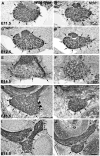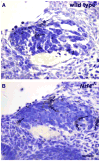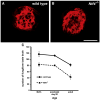Neurotrophin-4 regulates the survival of gustatory neurons earlier in development using a different mechanism than brain-derived neurotrophic factor
- PMID: 22353733
- PMCID: PMC3816093
- DOI: 10.1016/j.ydbio.2012.02.008
Neurotrophin-4 regulates the survival of gustatory neurons earlier in development using a different mechanism than brain-derived neurotrophic factor
Abstract
The number of neurons in the geniculate ganglion that are available to innervate taste buds is regulated by neurotrophin-4 (NT-4) and brain-derived neurotrophic factor (BDNF). Our goal for the current study was to examine the timing and mechanism of NT-4-mediated regulation of geniculate neuron number during development. We discovered that NT-4 mutant mice lose 33% of their geniculate neuronal cells between E10.5 and E11.5. By E11.5, geniculate axons have just reached the tongue and do not yet innervate their gustatory targets; thus, NT-4 does not function as a target-derived growth factor. At E11.5, no difference was observed in proliferating cells or the rate at which cells exit the cell cycle between NT-4 mutant and wild type ganglia. Instead, there was an increase in TUNEL-labeling, indicating an increase in cell death in Ntf4(-/-) mice compared with wild types. However, activated caspase-3, which is up-regulated in the absence of BDNF, was not increased. This finding indicates that cell death initiated by NT-4-removal occurs through a different cell death pathway than BDNF-removal. We observed no additional postnatal loss of taste buds or neurons in Ntf4(-/-) mice. Thus, during early embryonic development, NT-4 produced in the ganglion and along the projection pathway inhibits cell death through an activated caspase-3 independent mechanism. Therefore, compared to BDNF, NT-4 plays distinct roles in gustatory development; differences include timing, source of neurotrophin, and mechanism of action.
Published by Elsevier Inc.
Figures








Similar articles
-
Lingual and palatal gustatory afferents each depend on both BDNF and NT-4, but the dependence is greater for lingual than palatal afferents.J Comp Neurol. 2010 Aug 15;518(16):3290-301. doi: 10.1002/cne.22400. J Comp Neurol. 2010. PMID: 20575060 Free PMC article.
-
Taste neurons consist of both a large TrkB-receptor-dependent and a small TrkB-receptor-independent subpopulation.PLoS One. 2013 Dec 27;8(12):e83460. doi: 10.1371/journal.pone.0083460. eCollection 2013. PLoS One. 2013. PMID: 24386206 Free PMC article.
-
Epithelial overexpression of BDNF or NT4 disrupts targeting of taste neurons that innervate the anterior tongue.Dev Biol. 2001 Apr 15;232(2):508-21. doi: 10.1006/dbio.2001.0190. Dev Biol. 2001. PMID: 11401409
-
Neurotrophins in the ear: their roles in sensory neuron survival and fiber guidance.Prog Brain Res. 2004;146:265-78. doi: 10.1016/S0079-6123(03)46017-2. Prog Brain Res. 2004. PMID: 14699969 Review.
-
Taste neurons have multiple inductive roles in mammalian gustatory development.Ann N Y Acad Sci. 1998 Nov 30;855:50-7. doi: 10.1111/j.1749-6632.1998.tb10545.x. Ann N Y Acad Sci. 1998. PMID: 9929585 Review.
Cited by
-
The Role of Neurotrophin-4/Forkhead Box L1 in the Development of Nonsmall-Cell Lung Cancer.Contrast Media Mol Imaging. 2022 Aug 9;2022:9078012. doi: 10.1155/2022/9078012. eCollection 2022. Contrast Media Mol Imaging. 2022. PMID: 36034210 Free PMC article.
-
The transcription factor Phox2b distinguishes between oral and non-oral sensory neurons in the geniculate ganglion.J Comp Neurol. 2017 Dec 15;525(18):3935-3950. doi: 10.1002/cne.24312. Epub 2017 Sep 15. J Comp Neurol. 2017. PMID: 28856690 Free PMC article.
-
Identification of a postnatal period of interdependent neurogenesis and apoptosis in peripheral neurons.Biol Open. 2024 Nov 15;13(11):bio060541. doi: 10.1242/bio.060541. Epub 2024 Nov 11. Biol Open. 2024. PMID: 39527572 Free PMC article.
-
Insulin-Like Growth Factors Are Expressed in the Taste System, but Do Not Maintain Adult Taste Buds.PLoS One. 2016 Feb 22;11(2):e0148315. doi: 10.1371/journal.pone.0148315. eCollection 2016. PLoS One. 2016. PMID: 26901525 Free PMC article.
-
BDNF and NT4 play interchangeable roles in gustatory development.Dev Biol. 2014 Feb 15;386(2):308-20. doi: 10.1016/j.ydbio.2013.12.031. Epub 2013 Dec 27. Dev Biol. 2014. PMID: 24378336 Free PMC article.
References
-
- Abercrombie M. Estimation of nuclear populations from microtome sections. Anat Rec. 1946;94:239–247. - PubMed
-
- Agerman K, Baudet C, Fundin B, Willson C, Ernfors P. Attenuation of a caspase-3 dependent cell death in NT4- and p75-deficient embryonic sensory neurons. Mol Cell Neurosci. 2000;16:258–268. - PubMed
-
- Agerman K, Hjerling-Leffler J, Blanchard MP, Scarfone E, Canlon B, Nosrat C, Ernfors P. BDNF gene replacement reveals multiple mechanisms for establishing neurotrophin specificity during sensory nervous system development. Development. 2003;130:1479–1491. - PubMed
-
- Al-Hadlaq SM, Bradley RM, MacCallum DK, Mistretta CM. Embryonic genic-ulate ganglion neurons in culture have neurotrophin-specific electrophysiological properties. Neuroscience. 2003;118:145–159. - PubMed
-
- Altman J, Bayer SA. Development of the cranial nerve ganglia and related nuclei in the rat. Adv Anat Embryol Cell Biol. 1982;74:1–90. - PubMed
Publication types
MeSH terms
Substances
Grants and funding
LinkOut - more resources
Full Text Sources
Molecular Biology Databases
Research Materials

